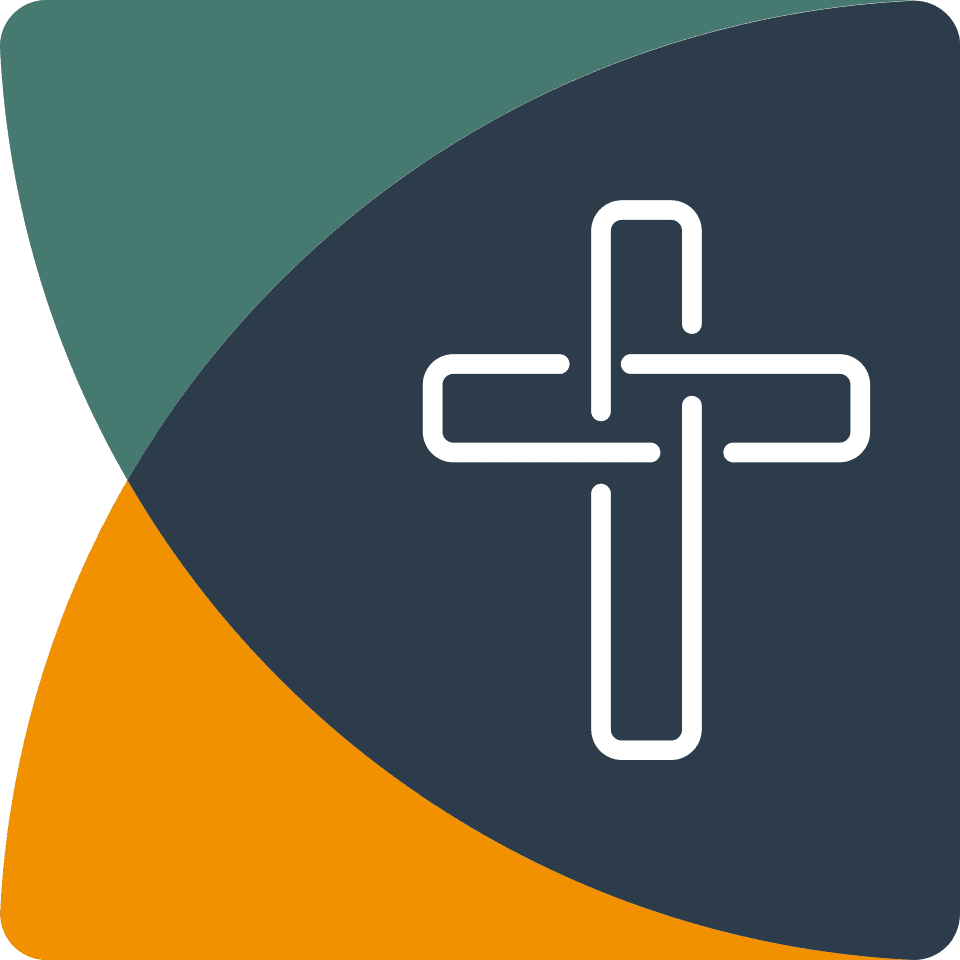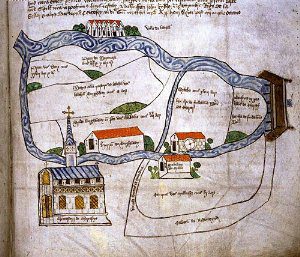History of Chertsey Abbey
Chertsey Abbey was founded in AD 666 by Frithuwold, Viceroy of Surrey, which was then ruled by Wulfhere, King of Mercia
Below is the foundation charter:
+ Regnante domino nostro Jhesu Christo in perpetuum . Ego Wlfarius rex Mercianorum . largiente domino et omnibus sanctis ejus omnes terras quas Fritheuualdus subregulus et beatus Erkenuualdus Ecclesiæ sancti Petri Certeseye dederunt æternaliter confirmo . et præcipio in nomine sanctæ et individuæ trinitatis ut omnes supranominatæ terræ æternaliter sint liberæ ab omni jugo terrenæ servitutis . necnon et hoc præcipio in nomine Dei omnipotentis et omnium sanctorum ejus quod nullus Rex aut episcopus vel aliquis alius potens sit tam audax ut huius meæ confirmacionis condictum confringere præsumat .Si quis vero hanc confirmacionem adaugere voluerit adaugeat ei Deus præmium in regno cœlorum. Si quis autem minuerit minuatur merces ejus hic et in regno Dei nisi prius cum satisfactione digna emendaverit. Amen.
The first Abbot was Earconwald, who later became Bishop of London. A sister house at Barking was founded by Earconwald’s sister, Æthelburh.
“When Sebbi… ruled the East Saxons, Theodore [Archbishop of Canterbury] appointed over them Earconwald to be their bishop in the city of London . . . before he was made bishop [he] builded two goodly monasteries, one for himself [at Chertsey in Surrey], the other for his sister Ethelburga .. . in the province of the East Saxons at the place that is named in Bericingum…” (Bede)
Chertsey Abbey held land far and wide, for example, the first record of Couldsdon near Croydon is a charter of 675 granting the Manor of “Curedesdone” to Chertsey Abbey. There was also land at Ecga’s Ham (Egham). The Domesday book records Bocheham (Bookham), Biflet (Byfleet), Certesi (Chertsey town), Cebeham (Chobham), Clanedun (Clandon), Covenham (Cobham), Epingeham (Effingham), Epsom, Estreham (Ham), Henlei (Henley), Patricesham (Petersham), Sudtone (Sutton), Torp (Thorpe), Totinges (Lower Tooting) and Webruge (Weybridge) as all being held by Wulfwold, Abbot of Chertsey.
Chertsey Abbey was raided and sacked by the Vikings during the 9th Century, the Abbot Beocca and about 90 of the priests being martyred. Orthodox Christians record April 23rd (Gregorian) (April 10th Orthodox Julian) as the day of “Martyrs Beocca, Hethor, and 90 monks, at Chertsey (+869)”.
Following this destruction, it was re-built and re-founded by King Edgar in AD 964 and he assigned the Abbey to the Benedictine Order under the charge of Æthelwold, Bishop of Winchester. In AD 999, Abbot Livingus became Bishop of Wells and in AD 1013, Archbishop of Canterbury.
A.D. 964. This year drove King Edgar the priests of Winchester out of the old minster, and also out of the new minster; and from Chertsey; and from Milton; and replaced them with monks. And he appointed Ethelgar abbot to the new minster, and Ordbert to Chertsey, and Cyneward to Milton.A.D. 1084. In this year died Wulfwold, Abbot of Chertsey, on the thirteenth day before the calends of May.
A.D. 1110. In this year held the King Henry his court at Christmas in Westminster, …. This year men began first to work at the new minster at Chertsey.” (The Anglo-Saxon Chronicle)
The Abbey and Monastery were rebuilt in 1110 by Hugh, Abbot of Winchester and it continued until it reached its prime under the benevolent care of John de Rutherwyk, “a venerable Abbot, who might be termed the convent’s second founder, the restorer of all really good works, and the substantial improver of the manors belonging to the monastery”. You may find more detail of the structure and site layout of the medieval Abbey here.
King Edward III visited Chertsey Abbey in 1341, and in 1471, during the Abbacy of John May, the body of King Henry VI was laid to rest there, following his murder in the Tower of London.
“On the morning of the 22nd of May, 1471 Henry VI was found dead in the Wakefield Tower. Although the official cause of death was reported as ‘pure displeasure and melancholy’, the chronicler John Warkworth wrote the following: ‘And the same night that King Edward came to London, King Henry, being inward in prison in the Tower of London, was put to death, the 21st of May, on a Tuesday night, between eleven and twelve of the clock, being then at the Tower the Duke of Gloucester, brother to King Edward, and many others; and on the morrow he was chested and brought to [St.] Paul’s , and his face was open that every man might see him; and in his lying he bled on the pavement there; and afterward at the Black Friars was brought, and there he bled new and fresh; and from thence he was carried to Chertsey Abbey in a boat, and buried there in our Lady Chapel.’”
In 1484, his remains were removed to Windsor by Henry VII as Chertsey Abbey was in danger of becoming a major site of pilgrimage due to the attribution of numerous miracles to his remains.
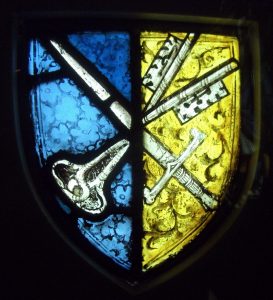 The Abbot of Chertsey was one of the Mitred Abbots who were permitted to wear Episcopal ornaments. The arms of Chertsey Abbey are on the left.
The Abbot of Chertsey was one of the Mitred Abbots who were permitted to wear Episcopal ornaments. The arms of Chertsey Abbey are on the left.
The Abbey suffered its final demise during the reign of Henry VIII, when on 6th July 1537 it was surrendered as part of the dissolution. The Abbot, John Corderoy and fourteen monks temporarily moved to Bisham Priory in Berkshire but this in turn was dissolved a year later.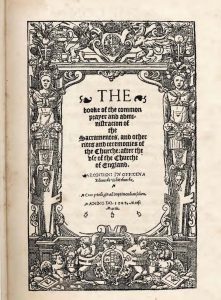
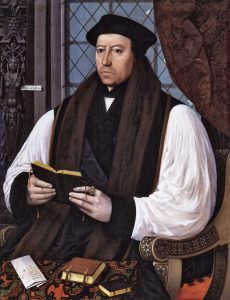 During the 1540’s, Thomas Cranmer (right) was working on the Book of Common Prayer, and much of his work is thought to have been carried out at Chertsey Abbey (possibly in the Chapter House), due to its proximity to Windsor and Hampton Court. There is a reference to the index of Archbishop Cranmer’s original Register in Lambeth Library, which records that the nomination and consecration of Dr. Ferrar to St. David’s Cathedral in Wales took place on the 9th of September, 1548, at Chertsey. Bishop Ferrar was martyred in 1555.
During the 1540’s, Thomas Cranmer (right) was working on the Book of Common Prayer, and much of his work is thought to have been carried out at Chertsey Abbey (possibly in the Chapter House), due to its proximity to Windsor and Hampton Court. There is a reference to the index of Archbishop Cranmer’s original Register in Lambeth Library, which records that the nomination and consecration of Dr. Ferrar to St. David’s Cathedral in Wales took place on the 9th of September, 1548, at Chertsey. Bishop Ferrar was martyred in 1555.The fate of Chertsey Abbey was, however, sealed, and over the next few years, the Abbey and its orchards were demolished and stripped by the King to construct Oatlands Palace near Weybridge. Any remaining stone was taken to raise the streets of Chertsey and other local villages. By 1673 only the outwalls remained and by 1752 they had almost vanished. The only evidence now remaining is some stonework and paving which can be seen in Abbey Gardens, reached by way of Church Walk at the east end of the church and of course the fishponds (which still fill with water after heavy rain).
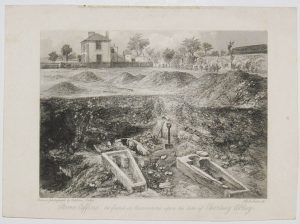 The grounds were sold and built upon, and a visitor, Dr. Stukely in 1752 reported his dismay at the total ruination of the Abbey and the discovery of human bones (from the graveyard), pieces of masonry, effigies, crosses and marble all over the garden of the house.
The grounds were sold and built upon, and a visitor, Dr. Stukely in 1752 reported his dismay at the total ruination of the Abbey and the discovery of human bones (from the graveyard), pieces of masonry, effigies, crosses and marble all over the garden of the house.
He says “I left the ruins of this place, which had been consecrated to religion ever since the year 666, with a sigh for the loss of so much national magnificence and national history. Dreadful was the storm which spared not at least the churches, libraries, painted glass, monuments, manuscripts; that spared not a little out of the abundant spoil to support them for the public honour.”
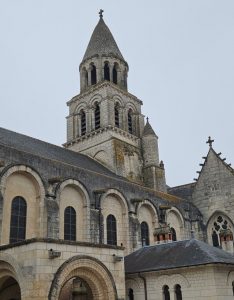 The Abbey was 275 feet long and when dissolved may well have resembled Westminster Abbey in size and magnificence. A near approximation to an image of the spire as shown on the Abbots seal (at the top of this page) may be Notre Dame la Grande at Poitiers.
The Abbey was 275 feet long and when dissolved may well have resembled Westminster Abbey in size and magnificence. A near approximation to an image of the spire as shown on the Abbots seal (at the top of this page) may be Notre Dame la Grande at Poitiers.
The famous Chertsey Curfew bell, (cast around 1310 and recast following damage in 1374) was saved from the Abbey and now rings as number 5 bell in St. Peter’s Church in the town. This church was built around 1300 – the bell tower and chancel survive from this date but the nave was replaced in 1806. The church was consecrated to All Saints but took the name of St. Peter’s from the Abbey following the dissolution.

